Beginners in the reef-keeping hobby are often overwhelmed by the sheer number of coral species available for their first nano reef tank. While it is true that any coral will thrive when given the right conditions, some are better suited for smaller tanks than others. This article will discuss 15 of the best corals for nano reef tanks.
15 Best Corals For Nano Reef Tanks
1. Candy Cane Corals
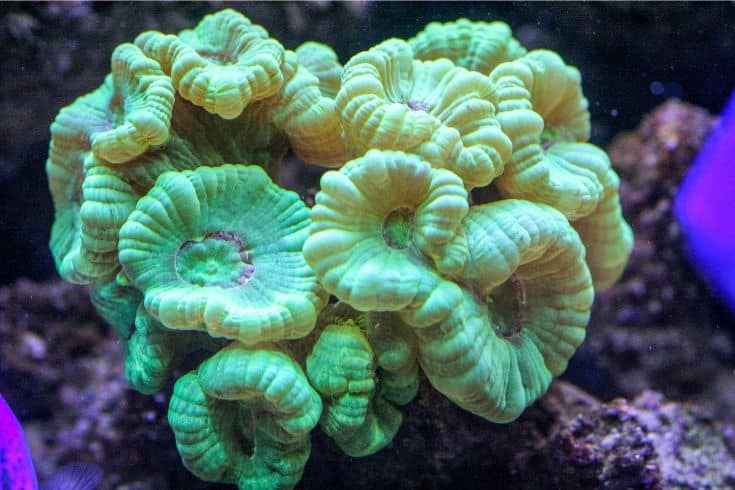
- Care Level: Easy
- Growth Rate: Fast
- Lighting: Low to moderate
- Flow: Mild water flow
- Compatibility: Can be kept with other euphyllia species
The candy cane coral is the first entry on our list. These beautiful corals are a type of euphyllia with long, flowing tentacles that come in various colors. They are one of the easiest corals to care for, regardless of your level of experience.
In the wild, these corals are generally found in sheltered, sandy areas with pristine water quality and minimal water movement. In the home aquarium, they should be provided with similar conditions. They will do best in low to moderate lighting and flow, and can be kept with other euphyllia species.
Candy cane corals are fast-growing and can quickly spread throughout the aquarium if given adequate space. Like many corals, they will also appreciate some supplemental feeding from small meaty foods. Overall, these corals are a great choice for beginner reef keepers.
2. Pulsing Xenia
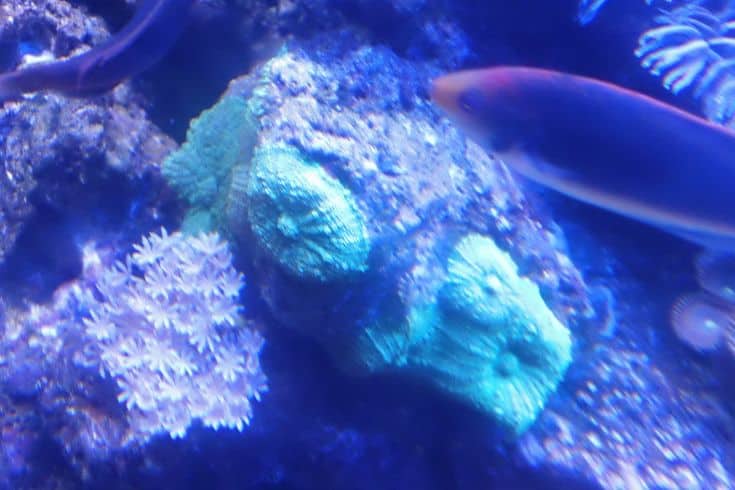
- Care Level: Easy
- Growth Rate: Moderate to Fast
- Lighting: Low to Moderate
- Flow: Medium to Strong
- Compatibility: All corals
For many seasoned reefkeepers, the pulsing xenia presents a unique challenge. This is one of the very few corals that thrive in an environment with higher phosphate and nitrate levels – conditions that aren’t ideal for most corals. But for entry-level aquarists, the pulsing xenia is a little more forgiving and easier to care for.
These beginner corals get their name from the rhythmic pulsing motion of their fleshy polyps. There’s no consensus on what exactly causes this pulsing behavior, but it is thought to be a means of expelling waste and toxins from the coral’s system. Whatever causes it, the pulsing motion makes for a very interesting and visually appealing coral.
Pulsing xenia are found in many colors, from bright green to deep purple. They can be kept in most nano reef aquariums, but will do best in tanks with adequate lighting. These hardy species can quickly spread throughout the aquarium if given adequate space.
3. Zoanthids
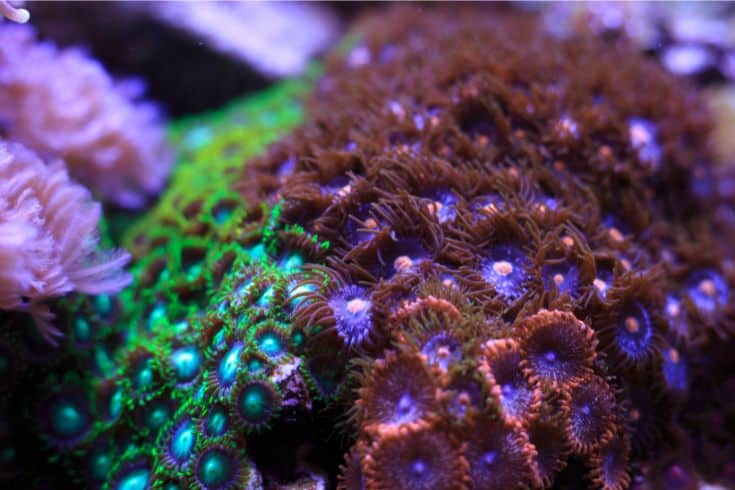
- Care Level: Easy
- Growth Rate: Slow to Medium
- Lighting: Medium to High
- Flow: Medium
- Compatibility: Will get along with other non-aggressive corals
This one has me feeling a little conflicted. On one hand, zoanthids are gorgeous, easy-to-care-for corals that make a great addition to any nano reef aquarium. On the other hand, some species cause palytoxin poisoning, a condition in which the toxins produced by the coral can lead to serious health problems in humans – even death.
Palytoxin poisoning is incredibly rare, and, more importantly, easily avoidable if you take the proper precautions. First and foremost, do not handle these corals with your bare hands. Always wear gloves when working with them, and wash your hands thoroughly after any contact. Secondly, do not place these corals in aquariums accessible to small children or pets.
Besides those two precautions, zoanthids make unique and beautiful additions to the nano reef aquarium. Their disc-like shapes, tentacles, and skittish behavior will almost certainly add some excitement to your tank. These corals do best in tanks with medium lighting and flow, so please keep that in mind when choosing a location!
4. Clove Polyps
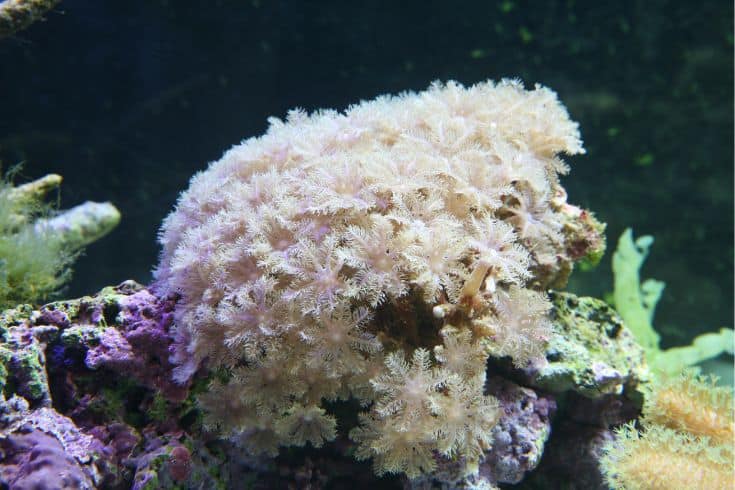
- Care Level: Easy
- Growth Rate: Slow
- Lighting: Moderate
- Flow: Moderate to high
- Compatibility: Will get along with other corals but may overgrow them
Clove polyps are soft coral that gets their name from their distinct clove-shaped structure. These corals are found in a wide range of colors, from bright green to deep purple, and can add some much-needed color and interest to the nano reef aquarium. Each polyp is attached to a primary segment known as the calyx.
The key distinguishing feature of clove polyps is their ability to retract their polyps into the calyx. This is generally done in response to changes in water quality or lighting but can also be a defensive mechanism to protect against predators. When the polyps are retracted, they appear as small bumps on the surface of the coral, leaving nothing but a colorful rock behind.
Clove polyps are easy to care for and do well in tanks with moderate lighting and flow. Though not an aggressive species, they may take over the tank if given too much space. As with all soft corals, be sure to provide plenty of room between them and other corals in the aquarium, and meet their minimum tank size requirements.
5. Anthelia Corals
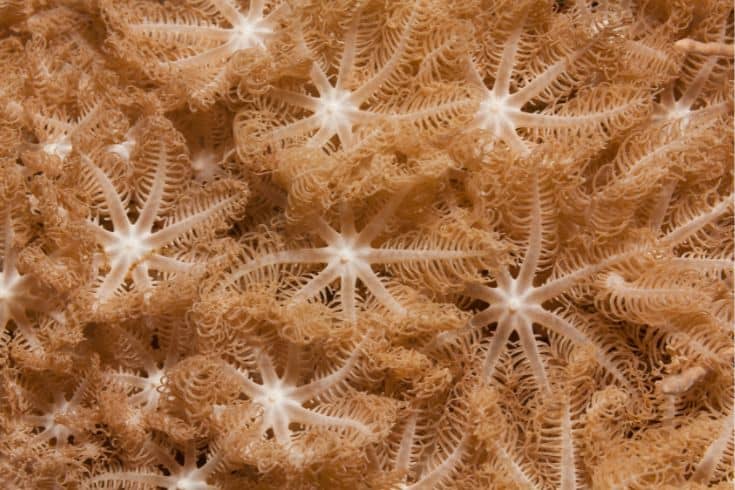
- Care Level: Easy
- Growth Rate: Fast
- Lighting: Moderate
- Flow: Moderate to strong
- Compatibility: Keep away from weak growers
Ever wanted to be greeted by the sight of a waving hand as you approach your aquarium? If so, then the Anthelia coral is the perfect choice for you! These corals get their name from their unique appearance – each polyp resembles a small hand with long, finger-like tentacles. These tentacles are used to capture food and can reach up to several inches in length.
Anthelia corals are fast-growing and do best in tanks with moderate lighting and strong water flow. They are not overly aggressive but may overgrow slower-growing corals if given too much space. As such, keeping them away from other corals that their growth might overpower is best. Anthelias exposed to sufficient light generally stay in their tank areas.
6. Toadstool Leather Corals
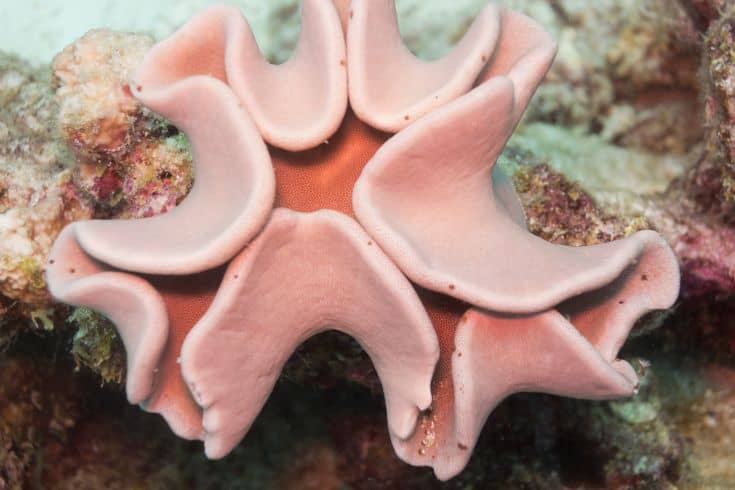
- Care Level: Easy
- Growth Rate: Fast
- Lighting: Moderate
- Flow: Moderate
- Compatibility: Keep only one if you’re using a nano tank
Toadstool leather corals get their name from their characteristic mushroom-like shape. These corals are a species of coral with a long stalk topped by a small “cap” of tissue. As the cap grows more prominent, it flows up and over the sides of the stalk, giving the toadstool its characteristic shape. These corals come in many colors, though green and yellow are the most common.
Toadstool leather corals are easy to care for and grow quickly, making them a good choice for the nano reef aquarium. They do best in tanks with moderate lighting and flow, and should be kept only one to a tank because they might compete with other corals for space. As is the case with most types of fast-growing corals, toadstools should be given plenty of room to spread out.
Another perk of keeping toadstool leather corals is that they don’t require feeding or supplementation. These corals get most of their nutrients from reef lighting, making them a low-maintenance addition to the aquarium.
7. Sun Corals
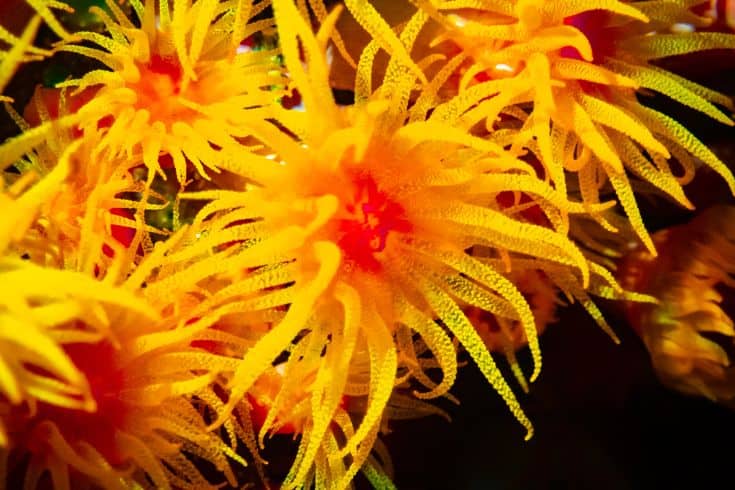
- Care Level: Moderate
- Lighting: Little to no light
- Flow: Moderate
- Compatibility: Compatible with most corals
As far as stone corals go, sun corals are some of the most unique-looking. These corals get their name from their bright colors and sunburst-like pattern of concentric circles. Sun corals are a type of LPS coral. The polyps are especially adept at capturing prey and snagging food that floats by.
Contrary to what their name suggests, sun corals don’t favor or need sunlight. These corals aren’t photosynthetic – they get most of their nutrients from the food they capture. Sun corals can be kept in tanks with little to no lighting. If you don’t want to invest in a ton of specialized reef lighting, this coral’s perfect for you.
Unfortunately, sun corals don’t photosynthesize, which makes them a bit more difficult to care for than other corals. These corals need to be fed regularly, and should be given a diet that includes meaty foods like brine shrimp and Mysis shrimp. You’ll also need to supplement their diet with calcium and other trace elements.
8. GSP Corals
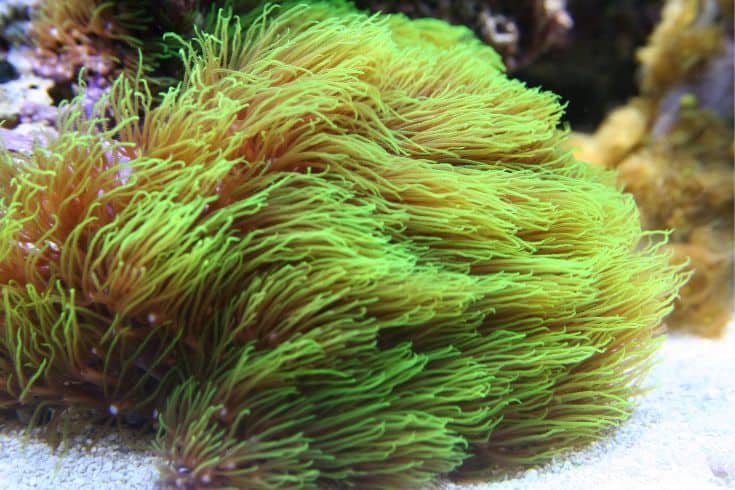
- Care Level: Easy
- Growth Rate: Fast
- Lighting: Moderate
- Flow: Moderate
- Compatibility: Has a tendency to grow over corals
So ubiquitous are they in the reef aquarium hobby that it is difficult to believe that Green Star Polyps are now simply known by their acronyms. But that speaks to this coral’s success in the home aquarium over the past several decades. GSPs are hardy and fast-growing, making them perfect for first-time reef keepers and expert aquarists.
Because these beginner-friendly soft corals are such fast growers, you’ll need to be prepared to trim them back regularly. GSPs can quickly overrun a nano reef tank if they’re not kept in check. Otherwise, however, they’re easy to care for and compatible with most other corals.
GSPs do best in tanks with moderate lighting and flow. They can tolerate a wide range of water conditions, but prefer temperatures between 72 and 78 degrees Fahrenheit. These corals also benefit from regular feedings of small, meaty foods.
9. Duncan Corals
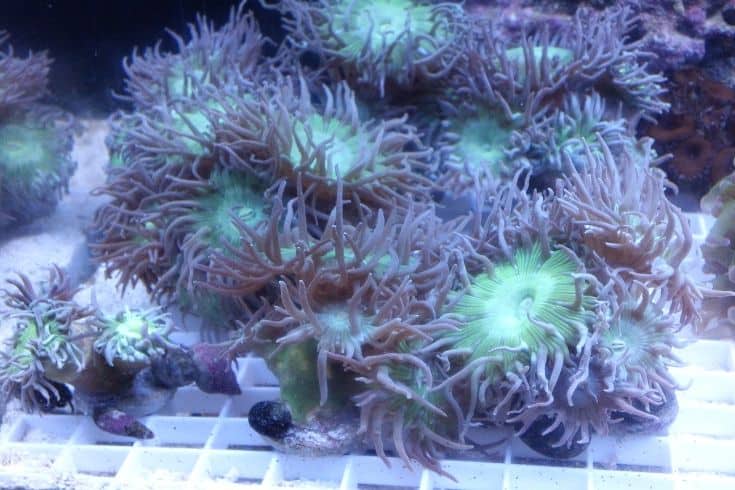
- Care Level: Moderate
- Growth Rate: Rapid
- Lighting: Low to moderate
- Flow: Low
- Compatibility: Compatible with most corals
The duncanopsammia axifuga, known colloquially as the Duncan coral, is a large polyp stony coral. Duncan corals are native to the Indo-Pacific region, typically found in the deep waters close to Australia. Like most corals with a calcified exterior, Duncans need hard water with high concentrations of calcium and magnesium for optimal growth.
Once you meet their basic needs for hard water, Duncan corals are a joy to have in your reef tank. They grow quickly, which means that even one frag can quickly become a full-blown colony. And because these corals are on the pricier end, their rapid growth is good news for your wallet.
Duncan corals do best in tanks with low to moderate lighting and flow. They’re not as tolerant of changes in water parameters as some other corals, so you’ll need to be extra careful about maintaining stable conditions in your tank. These corals also benefit from regular feedings of small, meaty foods, though they can also get by on photosynthesis.
10. Mushroom Corals
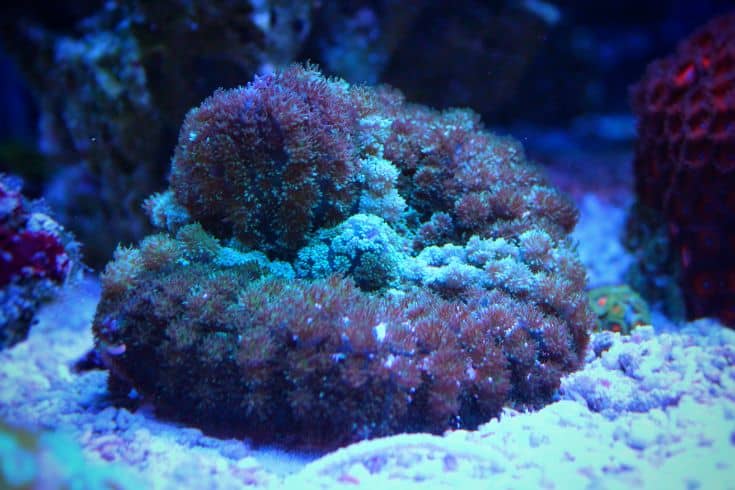
- Care Level: Easy
- Growth Rate: Rapid
- Lighting: Low to moderate
- Flow: Low to moderate
- Compatibility: Place with other rapid growers and away from slow-growers
As one of the easiest corals to care for, the mushroom coral is arguably the best coral for beginners. Most mushroom corals are native to environments with low nutrient and sediment levels, which makes them well-suited for life in the home aquarium. These corals would feel right at home in a general-purpose reef tank next to other easy-to-care-for corals like leather corals and recorded.
Mushroom corals live up to their name, with a large central “cap” and a base that attaches them to the substrate. Additionally, they are available in a wide range of colors and shapes, and are sometimes referred to as disc anemones because of their flat, disc-like caps. However, don’t be fooled: mushroom corals are not true anemones, and should not be kept with clownfish.
Those who have a true fascination for taxonomy might be interested to know that these are actually false corals. Unlike “true” corals, false corals do not possess exoskeletons – not even tiny skeleton remnants commonly found in soft corals. However, we think this is a non-issue. As long as your coral is healthy and happy, does it really matter what kind it is?
11. Birds’ Nest Corals
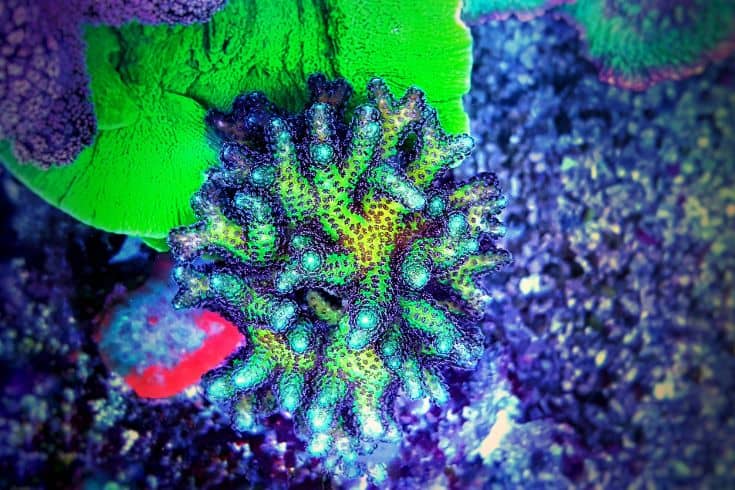
- Care Level: Moderate
- Growth Rate: Slow to moderate
- Lighting: Strong
- Flow: Moderate to high
- Compatibility: Can be kept with other corals in the Seriatopora genus
Judging by the name alone, it’s probably not surprising to learn that birds’ nest corals get their name from the spiky, dense cluster of stalks that make up their central mass. Though we’re certain that their stony exterior is not made out of bird feathers, we cannot help but be impressed by how closely they resemble a real bird’s nest.
Birds’ nest corals come in a wide variety of stunning colors – most commonly purple, green, yellow, or pink. Though these are some of the easiest SPS corals to care for, the task of keeping them alive is not for the beginner reefkeeper. To thrive, birds’ nest corals need adequate water quality and intense light levels. The best way to meet both needs is to place them close to the lights in your tank.
Reefkeepers who enjoy observing commensalist relationships will be happy to know that these corals are often home to a variety of small critters like crabs and shrimp. The Hapalocarcinus marsupialis crab for instance, is frequently found living on birds’ nest corals. These crabs shape the coral’s thin branches to form nice, tidy caves they call home.
12. Hammer Coral
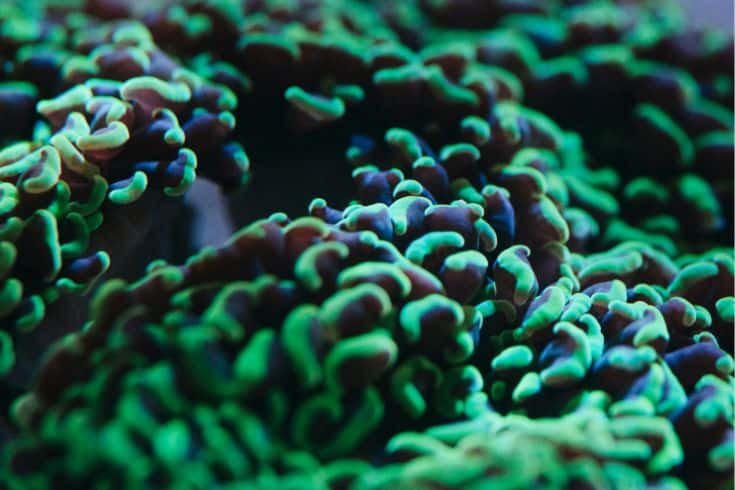
- Care Level: Moderate
- Growth Rate: Fast
- Lighting: Moderate
- Flow: Low to moderate water flow
- Compatibility: Can be kept with other euphyllia species
The hammer coral is sure to impress if you’re looking for uniqueness in a coral. These corals are easily recognizable by their large, flat caps and “hammered” texture. Though they come in various colors, including green, yellow, brown, and pink, their caps are usually some shade of tan or cream.
As photosynthetic corals, hammer corals need moderate lighting to help them grow and thrive. Though recommended, feeding is not necessary as they get most of their nutrients from photosynthesis. However, if you do choose to feed them, krill, Mysis, and plankton will all be readily accepted.
If you do choose to take on the challenge of keeping a hammer coral, be aware that they may sting nearby corals as a defense mechanism. As such, it’s best to place them away from other corals. In addition, these corals require highly stable water conditions and should not be exposed to sudden temperature changes or salinity changes.
13. Frogspawn Corals
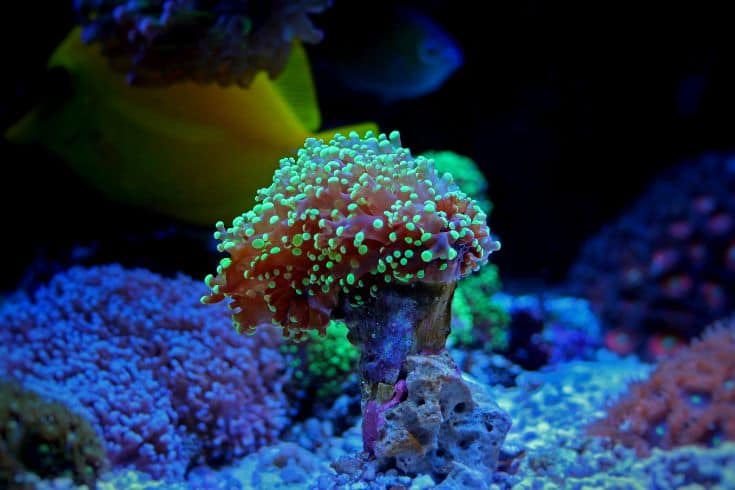
- Care Level: Moderate
- Growth Rate: Fast
- Lighting: Moderate
- Flow: Moderate
- Compatibility: Needs to be kept far away from other corals and kept solo if using a nano tank
The next entry on our list is one with a reputation for being feisty – the frogspawn coral. These corals get their name from their long, thin, sweeper tentacles resembling a frog’s legs. Sweeper tentacles are used by Frogspawn corals to protect their territory and can deliver a painful sting if they come into contact with another coral.
Given their well-earned reputation, it’s probably not surprising to learn that frogspawn corals must be kept away from other corals. It’s best to keep them solo if you’re using a nano tank. Once they grow large enough, we recommend fragging them and giving the new frag to another reefkeeper – it’s the best way to prevent your colony size under control.
Frogspawn corals are not the easiest to care for, but they are certainly a rewarding addition to any coral reef tank. These corals are fast growers, and will quickly fill up your nano aquarium. In addition, they come in a variety of colors, including green, yellow, brown, and pink. While they are not the most delicate corals, frogspawns will do their best in tanks with medium flow and lighting.
14. Pavona Coral
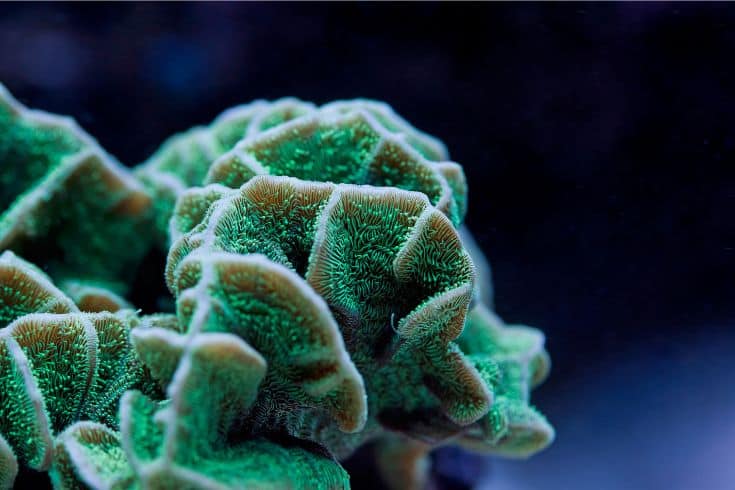
- Care Level: Easy to moderate
- Growth Rate: Fast
- Lighting: Medium to high
- Flow: Medium to high
- Compatibility: Keep solo if using a miniature reef aquarium
Pavona corals are a type of SPS coral. They come in different shapes and colors but are generally recognized by their distinctive pavonine pattern. The coral is currently available in shades such as blue, green, purple, and orange. However, because this coral is easy to propagate, new colors and patterns are constantly being created.
As far as SPS corals go, the Pavona is one of the hardier varieties. It can tolerate a wide range of water parameters and is relatively easy to care for. Minor fluctuations that normally hurt other corals will have little to no effect on a Pavona. However, you will still need to monitor your water conditions carefully because this coral is not immune to disease.
15. Hollywood Stunner Chalice
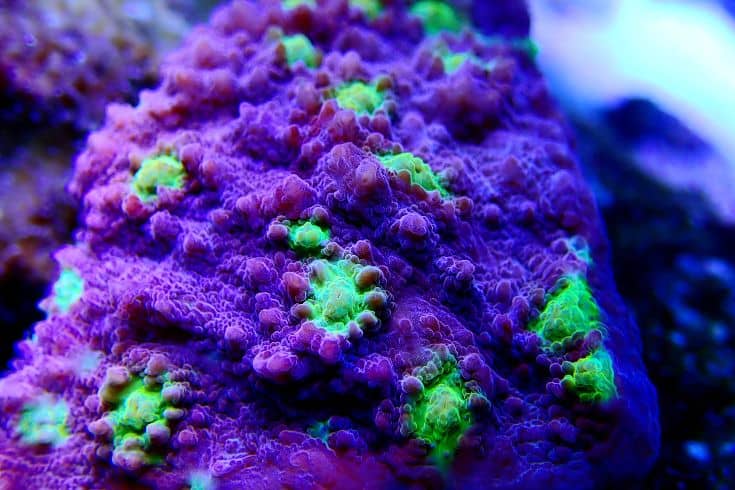
- Care Level: Moderate
- Growth Rate: Moderate
- Lighting: Moderate
- Flow: Low
- Compatibility: Not compatible with most species
With its stunning bright green neon “eyes, the Hollywood stunner chalice corals make excellent candidates for people who want a little bit of drama in their tank. Of the vast array of corals we have covered on this list, the Hollywood stunner is perhaps the most unique-looking. This coral is sure to turn heads with its bright colors and mesmerizing pattern.
But as beautiful as they are, Hollywood stunner chalice is picky about the company it keeps. In the wild, these corals are often found in areas with very little water movement. As such, they do not do well in inclement waters, and will often die if exposed to too much flow. In addition, they are not compatible with most species and should be kept solo in a nano aquarium.
When it comes to lighting requirements, Hollywood stunners do best in moderate light. Too much light will cause the coral to bleach, while too little light will cause it to fade and eventually die. So yes, Hollywood stunners are the goldilocks of the coral world. However, if you provide them with the conditions they require, they will reward you with their beauty for many years to come.
The Takeaway
We hope you found this list helpful! Nano reef tanks are a great way to enjoy coral’s beauty without investing in a large aquarium. These 15 types of corals will dazzle you with their attractive growth forms and unique traits.
Just remember to do your homework before filling your tank with corals. With proper care, these corals will thrive and add years of enjoyment to your reef tank. Thanks for reading!
